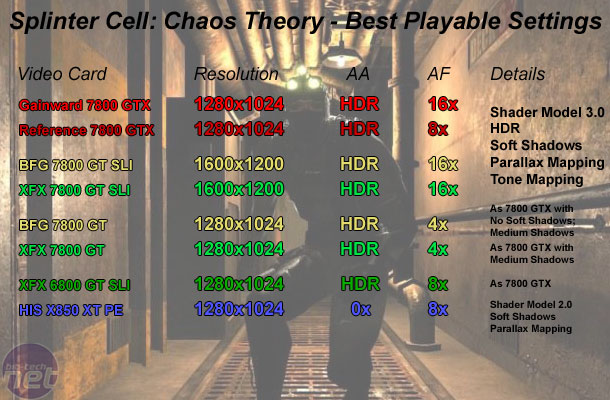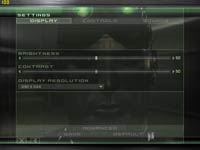Splinter Cell: Chaos Theory
Publisher: UbisoftWe are using the full version of Splinter Cell: Chaos Theory patched to version 1.04. It features a new game engine that has been created around a heavily modified Unreal Engine 2 - the game used to only have two shader profiles: Shader Model 1.1 and Shader Model 3.0. Meaning that all of ATI's current video cards default to Shader Model 1.1, and only the GeForce 6 series are capable of using the Shader Model 3.0 path.
However, the introduction of patch 1.04 bought a Shader Model 2.0 profile for ATI's current generation video cards. You can read more about the Shader Model 2.0 path here.
We configured both Anti-Aliasing and Anisotropic Filtering from within the game, and thus the driver control panel was left set to "Application Controlled".
Below is a table of the best-playable settings that we found best for each video card configuration. In this title, we found that 25 to 30 frames per second minimum and a target of 50 frames per second (or higher) for the average frame rate delivered a smooth and fluid gaming experience across the rest of the game.

The HIS X850 XT PE was able to deliver solid frame rates at 1280x1024 0xAA 8xAF using the new Shader Model 2.0 path. We could not turn HDR Lighting on though, as the performance deficit from enabling it would have meant running at 1024x768 in order to attain playable and smooth frame rates. As you will have seen last week, the HDR Lighting quality on the Radeon X850 XT PE is not quite as vibrant as what can be achieved when using a floating point blending technique to achieve HDR Lighting.
SLI scales really well in this title, and we went from being able to run with reduced image quality to the game's maximum details on both the BFGTech and XFX GeForce 7800 GT SLI configurations. We found that the XFX SLI was slightly quicker and smoother - the major difference was in the minimum frame rate, which was four frames per second to XFX's advantage: 32 fps as opposed to 28 fps on the BFGTech GeForce 7800 GT OC SLI.
Having said that, you can hardly complain about a 65 fps average frame rate and 28 fps minimum at the game's maximum details on two cards that are a lot more affordable than a pair of GTX's.

MSI MPG Velox 100R Chassis Review
October 14 2021 | 15:04








Want to comment? Please log in.